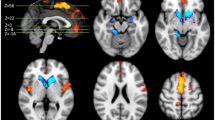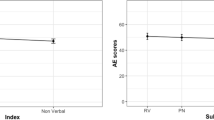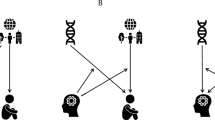Abstract
The parents of 15 autistic boys with a nonverbal IQ of at least 80 were compared with a matched group of parents of normal boys on the Goldstein-Scheerer Object Sorting Test and the Bannister, Fransella Grid Test of Thought Disorder. It was necessary to control for social class effects as abnormal scores on the thought disorder tests were more frequent in parents of manual social class. It was found that (a) there was a lack of agreement between the two tests of thought disorder, (b) the parents of autistic children showed thought disorder scores closely comparable to those of the parents of normals, and (c) there was no consistent association between thought disorder and anxiety. The methodological and substantive implications of the findings are discussed in relation to the results of previous investigations.
Similar content being viewed by others
References
Allen, G. J. The effect of three conditions of administration on “Trait” and “State” measures of anxiety.Journal of Consulting Clinical Psychology, 1970,34, 355–359.
Bannister, D., & Fransella, F. Grid Test of Schizophrenic Thought Disorder. Slough, Bucks, England: The National Foundation for Educational Research, 1967.
Bannister, D., Fransella, F., & Agnew, J. Characteristics validity of the grid test of thought disorder.British Journal of Social and Clinical Psychology, 1971,10, 144–151.
Bartak, L., & Rutter, M. Differences between mentally retarded and normally intelligent autistic children.Journal of Autism and Childhood Schizophrenia, 1976,6, 109–120.
Cox, A., Rutter, M., Newman, S., & Bartak, L. A comparative study of infantile autism and specific developmental receptive speech disorder. II. Parental characteristics.British Journal of Psychiatry, 1975,126, 146–159.
Creak, M. (Chairman). Schizophrenia syndrome in childhood: Progress report of a working party.Cerebral Palsy Bulletin, 1961,3, 501–504.
Desai, M. The relationship of the Wechsler-Bellevue Verbal Scale and the Progressive Matrices Test.Journal of Consulting Psychology, 1955,19, 108–110.
Foulds, G. A., & McPherson, F. M. Thought process disorder among schizophrenics.British Psychological Society Bulletin, 1966, A 18.
Foulds, G. A., Hope, K., McPherson, F., & Mayo, P. Cognitive disorder among the schizophrenias. I. The validity of some tests of thought disorder.British Journal of Psychiatry, 1967,113, 1361–1368.
Gathercole, C. E. A note on some tests of “overinclusive thinking”.British Journal of Medical Psychology, 1965,38, 59–62.
General Register Office.Classification of occupations. London: H.M.S.O., 1966.
Goldstein, K., & Scheerer, M. Abstract and concrete behaviour.Psychological Monographs, 1941,53, No. 239.
Hawks, D. V., & Marshall, W. L. A parsimonious theory of overinclusive thinking and retardation in schizophrenia.British Journal of Medical Psychology, 1971,44, 75–83.
Hodges, W. F., & Spielberger, C. D. Digit span: An indicant of trait or state anxiety.Journal of Consulting and Clinical Psychology, 1969,33, 430–434.
Kanner, L. Autistic disturbances of affective contact.Nervous Child, 1943,2, 217–250.
Kelly, G. A.The psychology of personal constructs. New York: Norton, 1955.
Lazarus, R. S., & Opton, E. M. The study of psychological stress: A summary of theoretical formulations and experimental findings. In C. D. Spielberger (Ed.),Anxiety and behaviour. New York: Academic Press, 1966. Pp. 225–262.
Lennox, C. Conceptual reasoning of parents of autistic children: A function of anxiety? B.Sc. thesis, University of Toronto. Substudy 73-3, Clarke Institute of Psychiatry Child & Adolescent Service, Toronto, 1973.
Lidz, T., Wild, C., Shafer, S., Rosman, B., & Fleck, S. Thought disorder in the parents of schizophrenic patients: A study utilizing the Object Sorting Test.Journal of Psychiatric Research, 1962,1, 193–200.
Lovibond, S. H. The Object Sorting Test and conceptual thinking in schizophrenia.Australian Journal of Psychology, 1954,6, 52–70.
McConaghy, J. The use of an Object Sorting Test in elucidating the hereditary factors in schizophrenia.Journal of Neurology, Neurosurgery and Psychiatry, 1959,22, 243–246.
McPherson, F. M., Blackburn, I. M., Draffan, J. W., & McFaden, M. A further study of the grid test of thought disorder.British Journal of Social and Clinical Psychology, 1973,12, 420–427.
Muntz, H. J., & Power, R. P. Thought disorder in the parents of thought disordered schizophrenics.British Journal of Psychiatry, 1970,117, 707–708.
Netley, C., Lockyer, L., & Greenbaum, G. Parental characteristics in relation to diagnosis and neurological status in childhood psychosis.British Journal of Psychiatry, 1975,127, 440–444.
Orne, M. T. Demand characteristic and the concept of quasi-controls. In R. Rosenthal & R. L. Rosnow (Eds.),Artefact in behavioral research. New York: Academic Press, 1969.
Payne, R. W., & Friedlander, D. A short battery of tests measuring overinclusive thinking.Journal of Mental Science, 1962,108, 362–367.
Payne, R. W., & Hewlett, J. Thought disorder in psychotic patients. In H. J. Eysenck (Ed.),Experiments in personality (Vol. 2). London: Routledge and Kegan Paul, 1960.
Payne, R. W., Mattussek, P., & George, E. I. An experimental study of schizophrenic thought disorder.Journal of Mental Science, 1959,105, 627–652.
Rapaport, D.Diagnostic psychological testing (Vol. 1). Chicago: The Year Book Publishers, 1945.
Raven, J. C.Guide to the Standard Progressive Matrices. Sets A, B, C, D, and E. London: H. K. Lewis & Co., 1958.
Romney, D. Psychometrically assessed thought disorder in schizophrenic and control patients and in their parents and siblings.British Journal of Psychiatry, 1969,115, 99–102.
Romney, D. The validity of certain tests of overinclusion.British Journal of Psychiatry, 1969,115, 591–592.
Rosenberg, M. J. The conditions and consequences of evaluation apprehension. In R. Rosenthal & R. L. Rosnow (Eds.),Artefact in behavioral research. New York: Academic Press, 1969.
Rosman, B., Wild, C., Ricci, J., Fleck, S., & Lidz, T. Thought disorders in the parents of schizophrenic patients: A further study utilizing the OST.Journal of Psychiatric Research, 1964,2, 211–221.
Rutter, M. The description and classification of infantile autism. In D. W. Churchill, G. E. Alpern, & M. K. DeMyer (Eds.)Infantile autism. Proceedings of the Indiana University Colloquium. Springfield, Illinois: Charles C Thomas, 1971.
Rutter, M. Childhood schizophrenia reconsidered.Journal of Autism and Childhood Schizophrenia, 1972,2, 315–337.
Rutter, M. Infantile autism and other child psychoses. In M. Rutter & L. Hersov (Eds.),Child psychiatry: Modern approaches. Oxford: Blackwell Scientific, 1977.
Schopler, E., & Loftin, J. Thinking disorders in parents of young psychotic children.Journal of Abnormal Psychology, 1969,74, 281–287.
Schopler, E., & Loftin, J. Though disorder in parents of psychotic children: A function of test anxiety.General Archives of Psychiatry, 1969,20, 174–181.
Spielberger, C. D., Gorsuch, R. L., & Luchene, R. E.STAI Manual for the State Trait Anxiety Inventory. Palo Alto, California: Consulting Psychologists Press, 1970.
Watson, C. G. Interrelationships of six overinclusive measures.Journal of Consulting Psychology, 1967,31, 517–520.
Winter, D. A. Some characteristics of schizophrenics and their parents.British Journal of Social and Clinical Psychology, 1975,14, 279–290.
Yates, A. J. Data processing levels and schizophrenia.Australian Journal of Psychology, 1966,18, 103–117.
Author information
Authors and Affiliations
Additional information
This study was supported in part by the Bethlem-Maudsley Research Fund.
Rights and permissions
About this article
Cite this article
Lennox, C., Callias, M. & Rutter, M. Cognitive characteristics of parents of autistic children. J Autism Dev Disord 7, 243–261 (1977). https://doi.org/10.1007/BF01539001
Issue Date:
DOI: https://doi.org/10.1007/BF01539001




